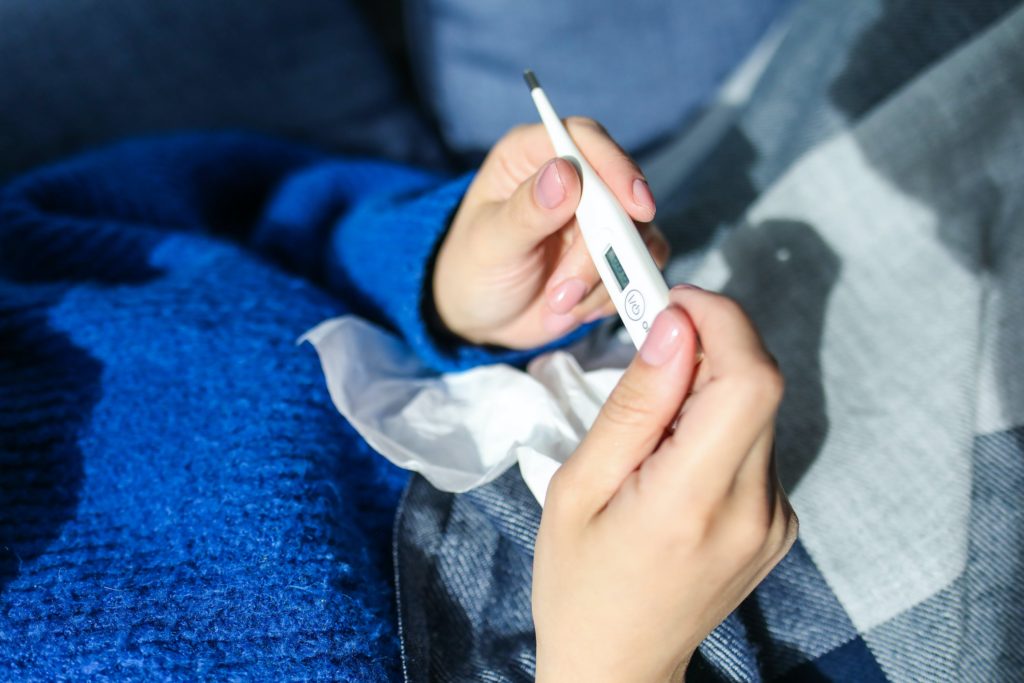
–by Dr. Peng E. Wang
Introduction
Influenza was first termed as early as 1504, meaning “outbreak” from Italy, and the flu symptoms were believed to be unfavorable astrological conditions, “influences of the stars” that caused the constellation of symptoms in the 1400s (Wiki). The history of influenza affects how we manage flu outbreaks today, considering flu causes major health complications. What’s the best way of treating the flu? How do you compare the flu symptoms to the common cold? How do you know when to quarantine? In this article, we look at the guidelines for influenza management and treatments.
| Influenza | The Common cold |
| Incubation: 1-4 days | Incubation: 10-12 hours |
| Sudden onset of symptoms and worsens in hours | Slow progression of symptoms over days |
| Fever >101F, severe body aches, chills, rigors (chill-to-the-bone feeling), loss of appetite | Fever <100F or typically none, some fatigue/aches/chills |
| Fast heart rate, palpitations due to dehydration | Typically none |
| Severe cough, wheezing & shortness of breath possible | Sneezing, runny nose, congestion, sinus pressure, drainage, cough |
| Nausea, indigestion, and diarrhea can occur | Typically none |
| Headache (front and behind eyes), congestion, sore throat, | Sinus pressure and frontal headache, sore throat, |
| Confusion due to dehydration, electrolyte imbalance | Typically none |
| Urinary tract infection can occur due to cough | Urinary tract infection can occur |
| Hives, atopic (eczema) due to heat/fever | Typically none |
Overview
The flu epidemic has been known to man as early as the 5th century B.C. based on ancient Rome writings, and it was named “influenza” when epidemics went across Europe (Wiki); history is vital because influenza outbreak is a public health concern and affects how you recognize the symptoms while minimizing transmission.
Many organisms can cause upper respiratory symptoms, and there are patterns you should recognize to suspect the flu versus the common cold. The management for flu and the cold is similar but has some distinct differences. The main difference is the risks of complications due to systemic effects, especially in the elderly and young people with chronic health issues.
It’s important to know what not to do when you have the flu; many treatments are available for an upper respiratory infection, and some remedies can worsen the progression of the illness, so it’s important to know what remedies to use and avoid.
The Flu Symptoms
Typically symptoms of the flu occur after 1-4 days of contact, and the flu lasts between 2-8 days (Wiki).
Common
- Sudden onset of generalized symptoms (fever, aches, chills)
- Fever above 101°Fahrenheit (38.3°Celsius)
- Rigors (chill to the bone feeling)
- Muscle pains (myalgia)
- Frontal headache
- Severe fatigue
- Severe cough
Less common
- Fever less than 100.4 °Fahrenheit (38 °Celsius)
- Nausea and diarrhea
- Sore throat
- Runny nose
Rare symptoms (Seek immediate care)
- Palpitations or fast heart rate due to dehydration
- Lightheaded and nearly passing out (presyncope)
- Confusion due to electrolyte imbalance
- Chest pain
Early recognition of flu symptoms can help you decide when to isolate. Additionally, it provides an estimate of the quarantine period and monitoring of the symptom progression. More importantly, the rare symptoms call for immediate evaluation because “walk-in” pneumonia and confusion can occur as complications. Pneumonia means there is a fluid collection in your lower airway, and bronchitis means you have a fluid collection in your mid-airway; these phrases do not equal bacterial infection.
The Flu Treatments
Recommended
Self-care tips
- Drink fluids with electrolytes (Gatorade, Smart Water, etc.)
- Dress in layers of clothing so you can adjust as needed
- Sleeping propped up about 30 degrees to reduce drainage
- Monitor your oxygen level (goal > 90%) by purchasing a pulse oximeter
- Monitor your heart rate level (goal < 120) by purchasing a pulse oximeter
- Supplements including Zinc and multivitamins can increase the co-factors your body needs to fight the infection since they will be utilized more
- Natural remedies such as honey, Echinacea, Elderberry, and Eucalyptus reduce the toxicity/irritability of the mucus thus helping with painful throat and reducing inflammation in turn
Antihistamines type 1; over-the-counter; best to be scheduled
- Claritin, the active ingredient is loratadine, with fast onset in one hour if taken on an empty stomach
- Clarinex, active ingredient is desloratadine, an analog of Claritin, has fewer side effects
- Zyrtec, active ingredient is cetirizine, with fast onset in one hour if taken on an empty stomach
- Xyzal, the active ingredient is levocetirizine, an analog of Zyrtec, with fewer side effects
Antihistamines type 2; over-the-counter; reduces nausea by reducing acid
- Pepcid, the active ingredient is famotidine, has a fast onset in 1 hour, lasts 10 hours, and can be taken with food
Fever and pain reducer; over-the-counter
- Tylenol, active ingredient is acetaminophen, 500mg or 325mg, use as needed
Nasal steroid topicals; over-the-counter; as needed
- Flonase, the active ingredient is fluticasone propionate, slow onset, alcohol-based solution
- Nasacort, the active ingredient is mometasone, slow onset, non-alcohol based solution (less likely to cause nosebleed)
Cough suppressants; over-the-counter; as needed
Cough suppressants; Prescription; as needed
- Tessalon Perles, the active ingredient is Benzonatate, prescribed for common colds, and persistent cough
- Codeine is a common narcotic that functions through the mu receptor pathway (controlled prescription)
Non-steroid Anti-inflammatory Drugs (NSAID); best to be scheduled
**Avoid if you have nausea, indigestion, or diarrhea, use Tylenol instead
Multisymptoms cold remedy (only one recommended)
- Nyquil, active ingredients are acetaminophen, doxylamine, and dextromethorphan; as needed only
Reactive cough > 10 days use Inhaled corticosteroids; prescription only; best to be scheduled
- Fluticasone, known as Flovent, the powder form was discontinued; aerosol (HFA) available
- Mometasone, known as Asthmanex; aerosol (HFA) and Twisthaler (powder)
- Budesonide, known as Pulmicort; aerosol (HFA) or nebulized only
- Advair Diskus, fluticasone/salmeterol; with a long-acting form of albuterol, twice daily
- AirDuo Respiclick, fluticasone/salmeterol; same as Advair but has a generic, less expensive, twice-daily
- Breo Ellipta, fluticasone/vilanterol; only once daily, expensive
- Symbicort HFA, budesonide/formoterol, aerosol only
- Wixela, fluticasone/salmeterol; same as Advair, but has generic, less expensive, twice daily
Do Not recommend
Over-the-counter cold remedies (Ironically)
- Dayquil, active ingredients include phenylephrine and guaifenesin
- Nyquil Sinus, active ingredients include phenylephrine
- Alka-Seltzer Plus Severe Allergy Sinus Congestion & Headache
- Mucinex Cold/Flu, active ingredients include phenylephrine, a decongestant
- Any packaging that states “Cold and Sinus” and “Cold and Flu”
Mucus relief (expectorants)
- Mucinex, the active ingredient is guaifenesin, also in Robitussin and many cold medicines
- Mucinex Children’s Stuffy Nose
- Mucinex Sinus-Max Clear & Cool
Decongestants (Hides well in many remedies, look at the ingredients)
- Afrin nasal spray, the active ingredient is oxymetazoline
- QlearQuil 12-Hour Nasal Decongestant Moisturizing Spray
- Vicks Sinex 12-Hour
- Vicks Sinex Severe Decongest
- Mucinex Children’s Stuffy Nose
- Mucinex Sinus-Max Clear & Cool
- Dayquil, active ingredients include phenylephrine
Behind the counter
- Claritin-D, active ingredients are loratadine and pseudoephedrine
- Zyrtec-D, active ingredients are cetirizine and pseudoephedrine
- Allegra-D, active ingredients are fexofenadine and pseudoephedrine
- Mucinex-D, active ingredients are guaifenesin and pseudoephedrine
Antibiotics
- Z-pack, active ingredient is azithromycin
It depends…
- Tamiflu, the active ingredient is oseltamivir, reduces viral replication and must be used < 48 hours of symptoms
Tamiflu side effects include abdominal pain, nausea, diarrhea (1-10%), liver toxicity, and rarely a reported peeling rash called Steven-Johnson Syndrome (Medscape). While the benefit of Tamiflu is the reduction of symptoms and risk of complications, the adverse effects make it questionable to be an automatic recommendation. However, for the high-risk patient population, the use of Tamiflu is strongly recommended (IDSA).
Complications and Prevention
When you have the flu, the initial response of your body’s immune response is hyperactivity with mucus production and dilation of the arteries inside your airway. This occurs in the local region involving your sinuses, nasal cavity, and glands (tonsils); removing tonsils early isn’t a great idea since it’s a part of your immune system (Wiki).
Physical defense system against pathogens (NCBI)
- Nasal hairs block pathogens from entering
- Mucus trapping pathogens (mucus has its purpose)
- The angle between the pharynx (throat) and your nasal cavity prevents falling of pathogens into the airway
- Tonsils are your first immune response to a pathogen
- Ciliated hairs move mucus upward only keeping pathogens away from the lungs
Your body is trying to quarantine pathogens with mucus and inflammation while preventing mucus from accumulating in the lower airways (lungs). It is crucial to understand what not to do to increase the challenge. Ultimately, the challenge in a respiratory infection is to overcome impaired oxygen delivery due to fluid accumulation. Cold remedies with decongestants and expectorants risk fluid buildup in your airway and risk these complications.
Complications (post-flu)
- Middle ear infection; ear pains and fever >100.4F
- Serous otitis media; fluid behind the eardrum and hearing loss
- Bronchitis; fluid in the mid-airway causing wheezing, shortness of breath, and fever
- Pneumonia; fluid in the lower airway causing fever, fatigue, shortness of breath, and very ill feeling
When to see a doctor (non-emergent)
- Fever recurring after the initial fever has resolved
- Ear pain with a fever
- Sinus impaction (not draining) with a fever
- Cough lasting > 10 days without shortness of breath
Prevention
*Vaccination- regardless of how you feel about vaccines, this article is not debating the politics of it, but the science of it is that it reduces complications. The influenza vaccine varies yearly because it’s hard to predict the exact mutation of the virus, and the effectiveness is about 40-60% (CDC). While the flu shot does not eliminate the flu, it should make it milder and reduce the risk of complications and hospitalization. The death rate due to flu complications remains a significant one even today, ranging from 12-79K deaths yearly (IDSA).
- Avoidance of contact with ill individuals
- PPE (personal protective equipment) including masks and glasses
- Hand washing after contact
- Disinfect fomites (physical objects that were in contact with ill persons)
- Adequate sleep, exercise, and hydration
- Vitamin D3 to boost vitamin D levels (NIH)
Conclusion
When comparing the flu with the common cold, the main symptoms setting them apart are high fevers, severe fatigue, and the risk of complications. Influenza has a higher risk of causing dehydration from very high body temperatures and vomiting with diarrhea. With the onset of flu-like symptoms, there are things you should be doing and also not doing to optimize the symptoms control. Sound management should involve nausea control and electrolyte replacement to maintain adequate circulation while minimizing drainage and exaggerated inflammatory response. Many medications do the opposite, namely Mucinex and Dayquil. Your body’s defense system tries to quarantine and destroy the pathogens while learning and ready for the next time. With many treatment options available for the flu, it’s best to prevent and minimize complications, so get vaccinated, get adequate sleep, exercise, eat a healthy diet, and boost your vitamin D level since most of us are deficient.
Bonus: Decongestants, why you should avoid it
Can decongestants make you drain more and increase the risk of pneumonia? Possibly. The mechanism is more open airway by compressing the arteries lining the airway, thus allowing more space for drainage and more stomach upsets. Decongestants also cause rebound congestion, with elevated heart rate and blood pressure to a dangerous level. The difference between a vein and an artery is the amount of smooth muscle they are made of. Arteries have three layers of smooth muscle, and veins only have one. Veins are more elastic and compliant. Arteries are not very compressible. If you forcibly squeeze arteries by using decongestants, rebound congestion ensues. Bottles of nasal decongestants, such as Afrin (oxymetazoline), and others like phenylephrine in cold remedies, it’s best to avoid it.

Related article: The Cold Symptoms and Treatments